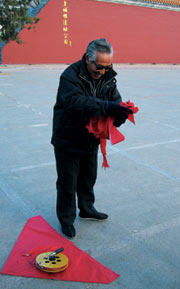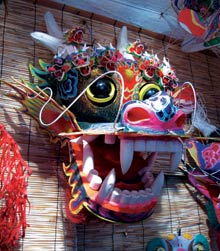| Go Fly a Kite! |
| http://www.sina.com.cn 2004/11/25 19:13 thats China |
Flying for Fitness
Many visitors to China are surprised by the number of elderly men they see flying kites because in the West, the pastime is generally reserved for the young. For avid kite flyers, however, it makes perfect sense. "Old people have worked all their lives and after retiring, have nothing to do," Liu says. "Flying a kite is good exercise: It gets you outside and you've got to run a bit and exert yourself to control the kite. While you're flying your kite, all that looking up eases built-up tension and will help relieve neck pain." Real-world testimonials support the traditional belief that kite flying cures. On a breezy afternoon just east of the Forbidden City, Mr. Wang is lightly tossing his swallow kite into the brisk wind, hoping to catch a lucky gust. He has been flying kites for just six months and became interested in it only after his neck and back pain got so bad, he couldn't work. "In the six months since I've been flying kites, my health has improved tremendously," he says, while giving the kite some slack. "I feel great. I don't really care much about the kites themselves, just about my health." Pointing out a fellow kite enthusiast who carefully avoids obstacles on earth while his eyes stay fixed on the sky, he says: "You see that guy there? He was injured on the job. Couldn't walk. Now look at him. He's been flying kites for three years." While Wang and others weave amongst themselves, avoiding mid-air collisions, another kite enthusiast sits on a nearby bench, touting their ability to improve eyesight. "All that staring in the sky, looking for your kites or avoiding others, is good for your eye muscles," he says. "I used to have poor vision when I started flying kites. Now, four years later, I no longer need to wear glasses." Continuing Traditions
Perhaps what most clearly distinguishes kite flying in China from elsewhere in the world is the intimate connection the activity has with traditional culture. Kites are designed to be poetry in the sky, with imagery and metaphors that draw on the vast reservoir of Chinese folktales and legend. According to Kong, the development of kites in China took a different course from those in the West. While both cultures take principles such as aerodynamics and wind tolerance into consideration when designing kites, Chinese kites are made to have "lingering charm and sentiment," Kong says. "Chinese kites must have a poetic quality." Liu Bin picks up one of the hard-wing kites and explains its significance. "This swallow kite is painted with a bat (bian fu) design. The sound 'fu' is homophonous with the word for 'fortune' in Chinese. There are ten bats visible, or shi fu, which sounds like the word for 'perfect and flawless.' These bats are carrying peaches in their hands, a scene described as shou tao, which again sounds like the word for 'longevity.' Looking at the entire kite, you've got shi fu shou tao - 'ten bats carrying peaches,' or 'perfect and flawless long life.'" The act of flying a kite also carries cultural weight. Beginning in the Qing Dynasty (1616-1911), people believed flying and then releasing a kite was a way to ward off bad luck and illness. "Once a kite is far enough away that you lose sight of it, you must take scissors and cut the thread," Liu says. "It's called fang zai, which means to take a year's worth of misfortune, place it upon the kite, and let it be carried away by the wind." For those unwilling to part with their kites, the act of reigning in the kite can be equally fortuitous. When the painted swallow kite described above is brought in, it is described as fu cong tian jiang "the bats descend from heaven" or "good fortune descends from heaven." You can take your pick. |
|
|
|
|
|
| Annotation |
| 新闻查询帮助 | |
| 热 点 专 题 | ||||
| ||||
|
教育频道意见反馈留言板 电话:010-62630930-5178 欢迎批评指正
新浪简介 | About Sina | 广告服务 | 联系我们 | 招聘信息 | 网站律师 | SINA English | 会员注册 | 产品答疑
Copyright © 1996 - 2004 SINA Inc. All Rights Reserved
版权所有 新浪网![]() 北京市通信公司提供网络带宽
北京市通信公司提供网络带宽

